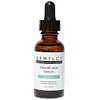What's inside
What's inside
 Key Ingredients
Key Ingredients

 Benefits
Benefits

 Concerns
Concerns

No concerns
 Ingredients Side-by-side
Ingredients Side-by-side

Water
Skin ConditioningGlycerin
HumectantPentylene Glycol
Skin ConditioningResveratrol
AntioxidantSodium Hyaluronate
HumectantBakuchiol
AntimicrobialEpigallocatechin Gallate
AntioxidantArginine/Lysine Polypeptide
Skin ConditioningBisabolol
MaskingAzelaic Acid
BufferingAloe Barbadensis Leaf Juice
Skin ConditioningSaccharide Isomerate
HumectantChamomilla Recutita Flower Extract
MaskingCucumis Sativus Fruit Extract
EmollientPropylene Glycol
HumectantRosmarinus Officinalis Leaf Extract
AntimicrobialAllantoin
Skin ConditioningSodium Hyaluronate Crosspolymer
HumectantLecithin
EmollientLeuconostoc/Radish Root Ferment Filtrate
AntimicrobialTocopherol
AntioxidantCaffeine
Skin ConditioningSodium Bisulfite
AntioxidantSodium Lactate
BufferingPullulan
Sodium PCA
HumectantTetrasodium Glutamate Diacetate
Xanthan Gum
EmulsifyingSclerotium Gum
Emulsion StabilisingSilica
AbrasiveEthylhexylglycerin
Skin ConditioningSodium Hydroxide
BufferingPhenoxyethanol
PreservativeCitric Acid
BufferingPotassium Sorbate
PreservativeSodium Benzoate
MaskingSorbic Acid
PreservativeSodium Citrate
BufferingWater, Glycerin, Pentylene Glycol, Resveratrol, Sodium Hyaluronate, Bakuchiol, Epigallocatechin Gallate, Arginine/Lysine Polypeptide, Bisabolol, Azelaic Acid, Aloe Barbadensis Leaf Juice, Saccharide Isomerate, Chamomilla Recutita Flower Extract, Cucumis Sativus Fruit Extract, Propylene Glycol, Rosmarinus Officinalis Leaf Extract, Allantoin, Sodium Hyaluronate Crosspolymer, Lecithin, Leuconostoc/Radish Root Ferment Filtrate, Tocopherol, Caffeine, Sodium Bisulfite, Sodium Lactate, Pullulan, Sodium PCA, Tetrasodium Glutamate Diacetate, Xanthan Gum, Sclerotium Gum, Silica, Ethylhexylglycerin, Sodium Hydroxide, Phenoxyethanol, Citric Acid, Potassium Sorbate, Sodium Benzoate, Sorbic Acid, Sodium Citrate
Water
Skin ConditioningGlycerin
HumectantNiacinamide
SmoothingSodium Chondroitin Sulfate
Skin ConditioningMethylglucoside Phosphate
Skin ConditioningCopper Lysinate/Prolinate
Skin ConditioningGlycosaminoglycans
EmollientBambusa Vulgaris Leaf/Stem Extract
HumectantPisum Sativum Extract
Skin ConditioningGlucosamine Hcl
Sodium Hyaluronate
HumectantPanthenol
Skin ConditioningPhenoxyethanol
PreservativeEthylhexylglycerin
Skin ConditioningPolysorbate 20
EmulsifyingDisodium EDTA
Water, Glycerin, Niacinamide, Sodium Chondroitin Sulfate, Methylglucoside Phosphate, Copper Lysinate/Prolinate, Glycosaminoglycans, Bambusa Vulgaris Leaf/Stem Extract, Pisum Sativum Extract, Glucosamine Hcl, Sodium Hyaluronate, Panthenol, Phenoxyethanol, Ethylhexylglycerin, Polysorbate 20, Disodium EDTA
 Reviews
Reviews

Ingredients Explained
These ingredients are found in both products.
Ingredients higher up in an ingredient list are typically present in a larger amount.
Ethylhexylglycerin (we can't pronounce this either) is commonly used as a preservative and skin softener. It is derived from glyceryl.
You might see Ethylhexylglycerin often paired with other preservatives such as phenoxyethanol. Ethylhexylglycerin has been found to increase the effectiveness of these other preservatives.
Glycerin is already naturally found in your skin. It helps moisturize and protect your skin.
A study from 2016 found glycerin to be more effective as a humectant than AHAs and hyaluronic acid.
As a humectant, it helps the skin stay hydrated by pulling moisture to your skin. The low molecular weight of glycerin allows it to pull moisture into the deeper layers of your skin.
Hydrated skin improves your skin barrier; Your skin barrier helps protect against irritants and bacteria.
Glycerin has also been found to have antimicrobial and antiviral properties. Due to these properties, glycerin is often used in wound and burn treatments.
In cosmetics, glycerin is usually derived from plants such as soybean or palm. However, it can also be sourced from animals, such as tallow or animal fat.
This ingredient is organic, colorless, odorless, and non-toxic.
Glycerin is the name for this ingredient in American English. British English uses Glycerol/Glycerine.
Learn more about GlycerinPhenoxyethanol is a preservative that has germicide, antimicrobial, and aromatic properties. Studies show that phenoxyethanol can prevent microbial growth. By itself, it has a scent that is similar to that of a rose.
It's often used in formulations along with Caprylyl Glycol to preserve the shelf life of products.
Sodium Hyaluronate is hyaluronic acid's salt form. It is commonly derived from the sodium salt of hyaluronic acid.
Like hyaluronic acid, it is great at holding water and acts as a humectant. This makes it a great skin hydrating ingredient.
Sodium Hyaluronate is naturally occurring in our bodies and is mostly found in eye fluid and joints.
These are some other common types of Hyaluronic Acid:
Learn more about Sodium HyaluronateWater. It's the most common cosmetic ingredient of all. You'll usually see it at the top of ingredient lists, meaning that it makes up the largest part of the product.
So why is it so popular? Water most often acts as a solvent - this means that it helps dissolve other ingredients into the formulation.
You'll also recognize water as that liquid we all need to stay alive. If you see this, drink a glass of water. Stay hydrated!
Learn more about Water